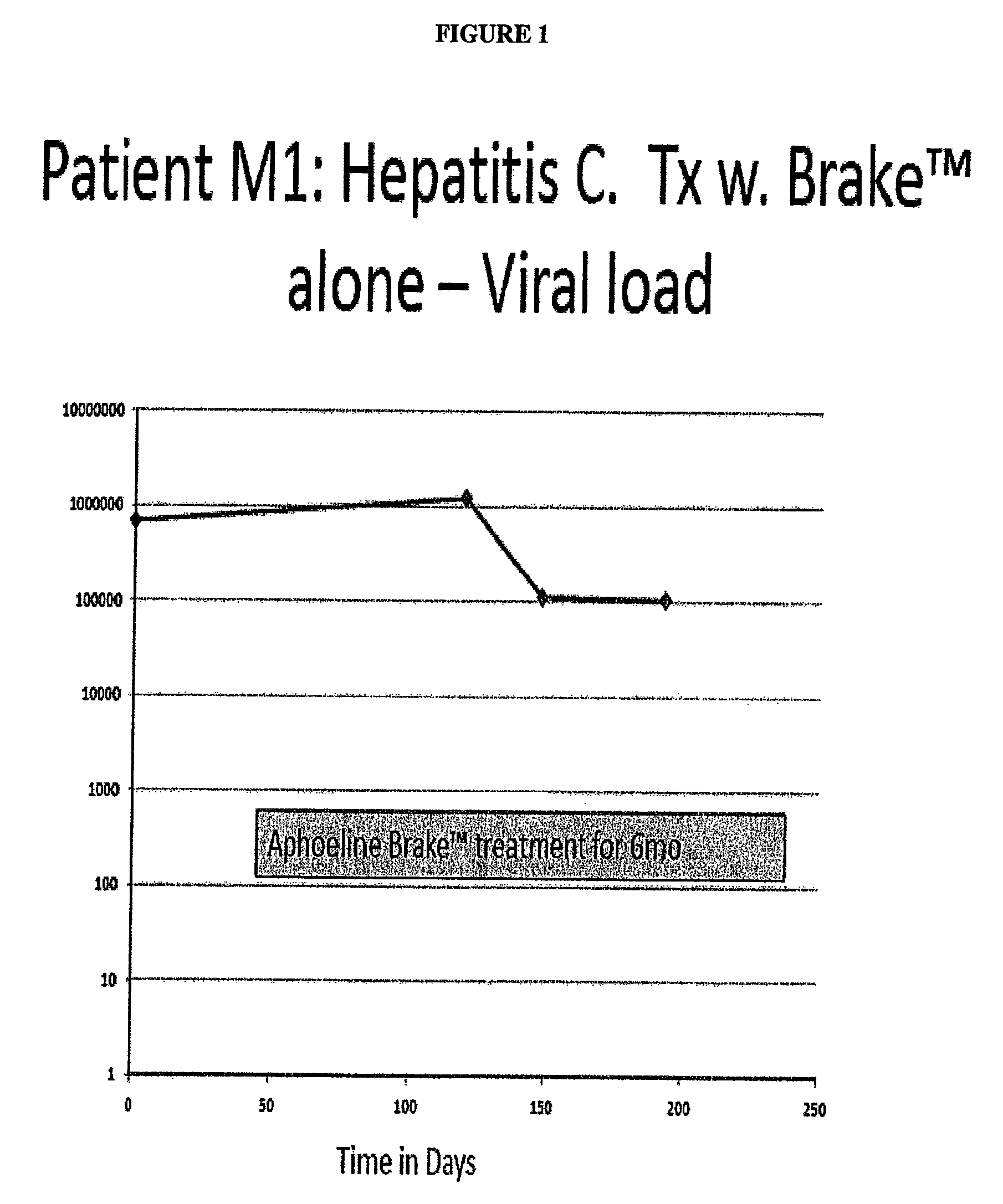Compositions, methods of treatment and diagnostics for treatment of hepatic steatosis alone or in combination with a hepatitis C virus infection
a technology for hepatic steatosis and hepatitis c virus, which is applied in the direction of drug compositions, plant/algae/fungi/lichens ingredients, and microcapsules. it can solve the problems of high cost and poor tolerance of current or future treatments, and the risk of side effects
- Summary
- Abstract
- Description
- Claims
- Application Information
AI Technical Summary
Benefits of technology
Problems solved by technology
Method used
Image
Examples
example 1
Comparison of the Impact of Brake™ in 18 Patients vs. RYGB in 15 Patients from the Perspective of Insulin Resistance, on Hepatic Enzymes and Triglycerides
A. Brake™ Treatment Population
Briefly, Aphoeline Brake™ formulation 2 (described above) was given for a minimum of 6 months to a group of 18 patients. Demographics of the 18 patients were as follows.
[0124]9 males, 9 females, ages 26-71[0125]1 African, 1 Asian, 3 Hispanics, 13 Caucasians[0126]11 pre / early diabetic with insulin resistance and elevated insulin, pro-insulin or HBA1c[0127]9 patients with Fatty Liver, 2 with liver biopsies, 7 of these were diabetic or pre-diabetic[0128]3 patients with Hepatitis C not on any antiviral treatments. Two of these had biopsy proven cirrhosis[0129]All patients were given 10 gm Brake™ once Daily, orally, 4 hrs prior to their main meal[0130]Patients treated and followed for 6 months[0131]Serial laboratory and biomarkers including BMI, body weight, hepatic profiles, Triglycerides and lipid profile...
example 2
Case 1: A Hepatitis C Patient with Moderate Viral Load Treated with Brake™ Alone, with the Goal to Evaluate the Secondary Antiviral Impact of Improving the Hepatic Steatosis
Patient M1 was a 55 yo female with a normal BMI. She had a renal transplant in 1998 and has been taking prednisone, Rapimmune, Synthroid, Nexium and Cozaar.
[0140]Hepatitis C Genotype 3 in 1998, Failed Treatment IFN / Riba ˜4 yr prior to this episode of care. Liver Biopsy 2004: Cirrhosis w. bridging fibrosis, stage 3 / 4[0141]She was not on Hepatitis C treatment since 2007; no antiviral drugs in the 3 years prior to Brake™ therapy.[0142]Added Aphoeline Brake™ (formulation II) at second visit[0143]Liver enzymes improved to normal over 3 mo[0144]Creatinine decreased to normal over 3 mo[0145]Alpha fetoprotein decreased rapidly[0146]Hepatitis C Viral count decreased rapidly to 100K (See FIG. 1)[0147]Patient M1 had one log reduction in viral titers[0148]M1 had previously failed IFN / Riba in 2004, was immunosuppressed with p...
example 3
Case 2: A Hepatitis C Patient with Combination Treatment of Brake™ and pegIFN / Riba, a Test of the Ability of Combinations to Reduce Viral Load Over that of pegIFN / Riba Alone
[0151]Patient E1 was a 36 year old male who was 5′7″ 1851b and had a BMI of 29 upon presentation for treatment of his hepatitis C genotype 1a TC virus. His pre-treatment liver biopsy showed hepatic steatosis and fibrosis 1 of 4. He was started on pegIFN / Riba with initial one log decline in viral load, but after the first month his dose was increased because of a plateau in viral load response. There was only a one log further decline. After two months with only moderate viral load response to this increased dosage, the patient had the addition of 10 gm per day of Aphoeline Brake™ added to his maximal dose pegIFN / Riba regimen.
[0152]As shown in FIG. 3 describing his viral load over time, he received this combination for 24 months and became negative for Hepatitis C virus for the past 10 months, which in the case is...
PUM
| Property | Measurement | Unit |
|---|---|---|
| pH | aaaaa | aaaaa |
| pH | aaaaa | aaaaa |
| pH | aaaaa | aaaaa |
Abstract
Description
Claims
Application Information
 Login to View More
Login to View More - R&D
- Intellectual Property
- Life Sciences
- Materials
- Tech Scout
- Unparalleled Data Quality
- Higher Quality Content
- 60% Fewer Hallucinations
Browse by: Latest US Patents, China's latest patents, Technical Efficacy Thesaurus, Application Domain, Technology Topic, Popular Technical Reports.
© 2025 PatSnap. All rights reserved.Legal|Privacy policy|Modern Slavery Act Transparency Statement|Sitemap|About US| Contact US: help@patsnap.com



